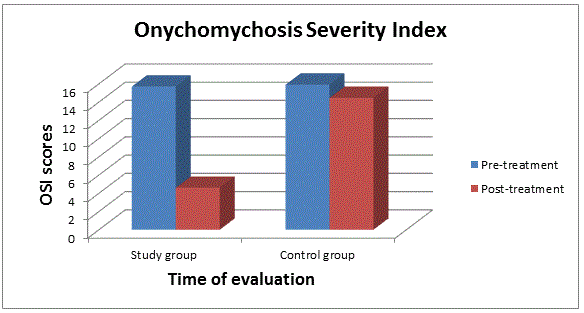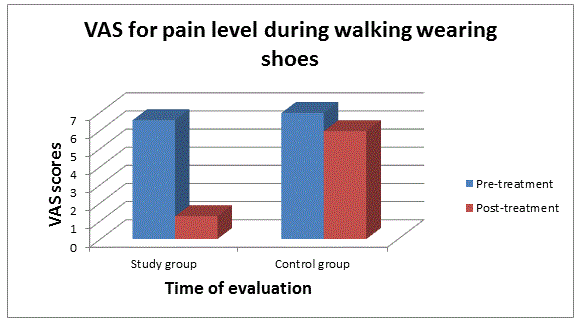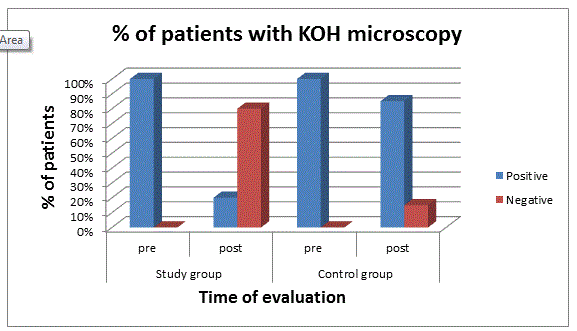Topical antifungal drugs have generally been distinguished as poorly efficient, mainly because of bad penetration into the toenail. Usually, topical treatment is desirable for patients with onychomycosis influencing only a few numbers of nails, particularly in cases where the disease time is shorter with least fungal involvement of the distal part of the nail. Despite of its low cure rate, and long treatment duration, it can be used as a choice treatment for those patients who couldn’t tolerate systemic therapy. Systemic antifungal drugs are very effective, but may be accompanied with high risk of systemic side effects. The rapid, trans-ungual iontophoretic drug delivery technique with high cure rates and with minimal systemic side-effects for treating toenail onychomychosis was developed.
The purpose of this study was to estimate the efficacy and safety of terbinafine HCl 1% iontophoresis as a topical antifungal treatment that may improve drug delivery to toenail onychomychosis. Three parameters were assessed in order to establish improvement: two objective methods (OSI scores & diagnosis with KOH microscopy) and one subjective method (the pain level during walking wearing shoes by VAS).
In the present study patients received terbinafine HCl 1% iontophoresis on the big toenail onychomycosis with an intensity of 3 to 4 mA/min. The procedure was under complete supervision of a physical therapist to detect any side effects. In comparing with the previous studies, the time of iontophoresis session was shorter (30 minutes) and the overall period of treatment was 4 weeks (short duration of treatment). The data analysis revealed that study the group which received active terbinafine HCl 1% iontophoresis therapy showed highly significant improvement in OSI scores that was used to classify the severity of onychomycosis, KOH microscopy which used to diagnose the presence of dermatophyte infections which cause toenail onychomycosis, and VAS which reported the pain level during walking wearing shoes, before and after treatment. On the other hand data analysis of the control group which received placebo terbinafine HCl 1% iontophoresis showed non-significant improvement in the same three parameters. Moreover the analysis between the two groups showed highly significant improvement in favor to the study group. Toenail onychomycosis was improved after treated by terbinafine HCL 1% iontophoresis only for 30 minutes, 3 times per week for four weeks (12 sessions) without any detected side effects with high terbinafine permeation across the nail plate under the influence of electric charge, as terbinafine HCl has a positive charge and was connected to the positive electrode of the iontophoretic unit to be rebelled to penetrate the nail bed. This is most likely due the fact that terbinafine HCl 1% iontophoresis is noninvasive, safe, short treatment period, and can be easily completed within few minutes per treatment session without any side effects. Patients of control group received active terbinafine HCL 1% iontophoresis as in study group after the end of the study to benefit from the procedure.
Nail is different from skin as it is a thick, hard keratin membrane with low lipid content (≤1%) [
23]. Iontophoresis includes delivery of ions across a membrane using an electromotive force. The principal pathway for iontophoresis in skin is known to be the follicular route, which it disappeared in nail. However, a hydrated nail is known to swell and behave more like a porous hydrogel matrix [
24]. Drug diffusion through the hydrated keratin of a nail may be improved by iontophoresis. Factors which are responsible for this improvement comprise electro-repulsion/electrophoresis- interaction between the electric field and the charge of the ionic permeant; electro-osmosis convective solvent flow in pre-existing and newly created charged pathways; and permeabilization/electroporation- electric field-induced pore induction. In contrast to passive transport, iontophoresis significantly enhanced drug penetration through the nail [
25]. Murthy et al. [
26], studied the effect of iontophoresis on the permeability of salicylic acid across human nail plate. They applied diffusion study using Franz diffusion cell. The results reported that extreme increase in the permeability across nail plate as compared with the routine method of penetration [
26].
Terbinafine is a well-established broad-spectrum antifungal drug with unique clinical efficacy integrated with good tolerability. Terbinafine HCl, a strong antifungal agent from allylamine antifungals, was chosen as a model drug because it is very impressive in treatment of dermatophyte infections and it is a drug option for treatment of onychomycosis [
27]. Recently, terbinafine HCl 1% iontophoresis has become one of the most effective therapies for toenail onychomychosis. The findings of the present study are generally in line with earlier reports of positive outcome treatment of toenail onychomychosis with terbinafine HCl 1% iontophoresis in the previous studies.
Initial studies reported that implementation of current (0.5 mA/cm²) could significantly increase the trans-ungual delivery of terbinafine. An increase in the implemented current or duration of current application increased the trans-ungual delivery of terbinafine. Terbinafine permeation through the nail and drug percentage in the nail correlated well with the used electrical dose. Light microscopy trials proven the ability of iontophoresis to drive a charged molecule across the nail plate. The results of Nair et al. [
28], indicated that iontophoresis could be developed as a potential technique for onychomycosis therapy [
28]. In another study by Nair et al. [
29], they reported that a short current time (max 60 min) and a safe current intensity (max 0.5 mA/cm²) would be preferred. With their applicator technique, treating more than finger/toe infections at the same time using a multiunit power supply should be possible. They concluded that local iontophoretic delivery of terbinafine to the nails would be able to result in much higher drug load levels compared to systemic delivery [
29].
In a preliminary study by Amichai et al. [
30], 38 patients were divided randomly into two groups, group A was treated with terbinafine and an iontophoretic patch and group B was treated with terbinafine without iontophoresis. Treatment was overnight wear (6-8 hours), every day, 5 days per week, for 4 weeks. Results showed a significant clinical response in patients of group A. They concluded that the delivery of terbinafine under an electrical current of 100 µA/cm² appears to be efficacious and safe for the treatment of nail onychomycosis [
16]. In another study by Amichai et al. [
30], iontophoresis was introduced through porcine and human nail
in vitro to evaluate its efficiency in increasing transference of terbinafine HCL. They reported that an optimal electrolyte concentration (1% NaCl or KCl) is needed for an effective transference. They concluded that iontophoresis was effective in increasing the trans-nail delivery of terbinafine [
30].
The findings of the current study suggested that terbinafine HCl 1% iontophoresis appeared to be effective and safe for the treatment of toenail onychomychosis as shown by improvement of OSI scores in the study group compared with the control group. This effect could be reinforced by negative reaction of KOH microscopy as well as by the reduction of pain scores during walking wearing shoes in VAS. It might be possible that successful toenail onychomychosis treatment would result from developing a topical treatment technique (iontophoresis) that will be able to give a high cure rates with short durations treatment.



